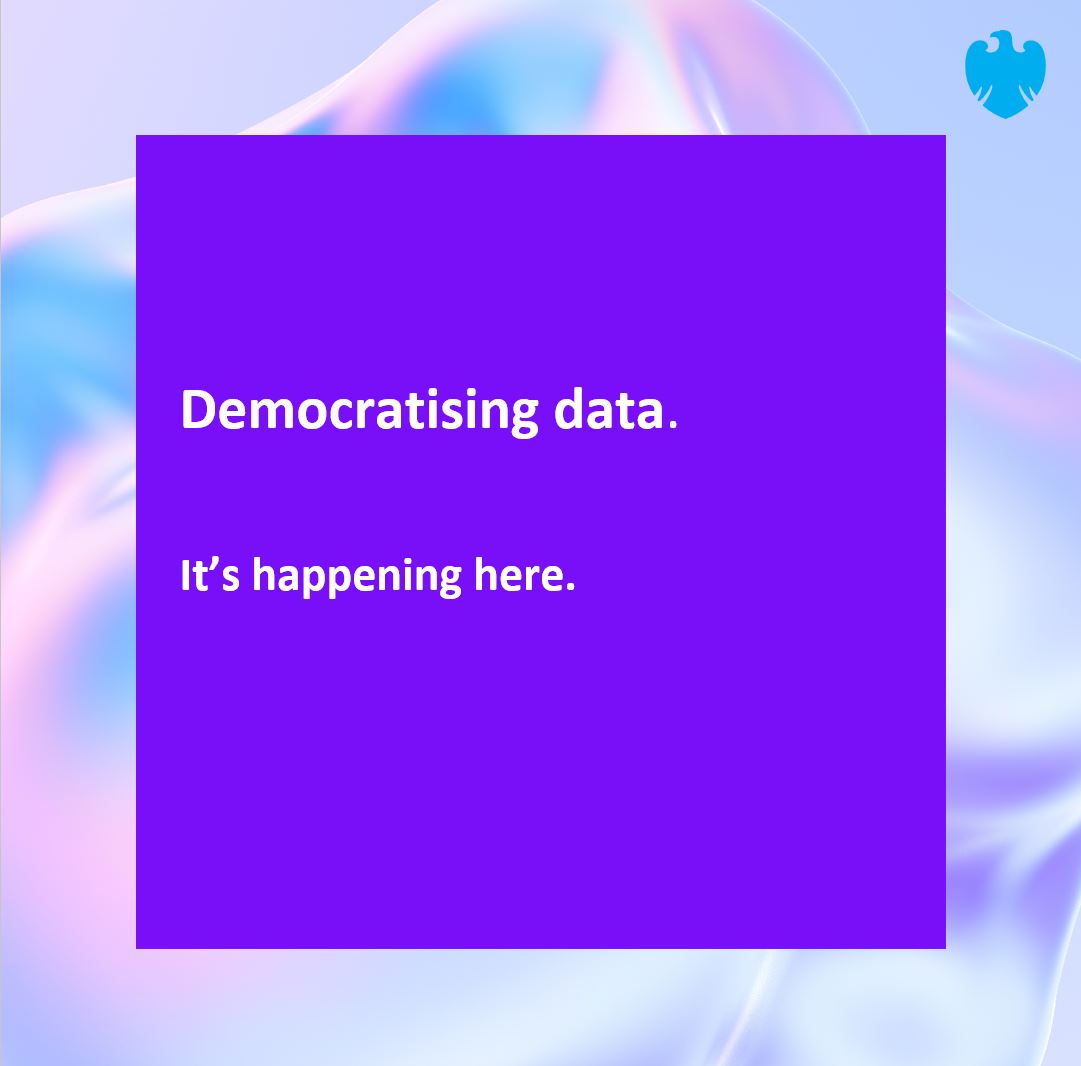The growing popularity of data
Alper Ozcakir understands the world of data better than most people. Working alongside Distinguished Engineer Ben George, a world-leading expert in Cloud and data technology, Alper’s team marshalls Barclays’ vast resources of information. But even he finds the mania for data surprising.
“I was writing a presentation the other day and I did that thing where you type a couple of words into a search engine to see what the predictive algorithm suggests.”
"It turns out that when you write ‘Data is the new…’ You get some enlightening suggestions. ‘Data is the new oil.’ 'Data is the new gold'. Data is the new currency, the new electricity, even the new soil."
“It’s funny – but also pretty accurate. It’s addictive - once you’ve got a taste for it, you want more. But you need the right tools to make it digestible. And if you have too much, it’s bad for you.“
The Cloud, the data lake and the lakehouses
Ben and Alper are the engineers leading Barclays’ move to the Cloud. The dream is to create a data lake that runs deep with useful, valuable insight. A lake hydrated by a thousand different streams of data. Not a swamp full of information without meaning. A lake so clear and transparent that everyone can dip in and draw out what they want. And a series of lakehouses that allow different users to access and analyse the data they need in the way they need it. Faster and better than ever before.
Data has to be usable to be valuable
It's a mammoth and fascinating set of challenges. But it comes from the simplest understanding. Data is valuable. But only if people can use it.
Mining data can be incredibly useful. But there’s no point getting lost in layers of data. It’s about knowing what you want to do it with it. And having the tools to make those tasks possible.
Alper Ozcakir
If there’s a business need, then people in the business will understand that better than the tech people looking after the data. So the ultimate goal is to empower non-tech people to access and draw insight from all that information for themselves.
From reactive to proactive data
Traditionally, banks are very good at collecting and recording data. At the heart of every product, service and transaction Barclays has offered ever since 1690, there’s been the transfer of data – on a ledger, in a loan agreement, on a bank statement, on your smart phone app. Things change, money moves, prices fluctuate, the bank keeps score.
More recently, banks have got pretty good at managing their data reactively, ordering data streams to meet regulatory demands. So Barclays global operations sat on top a veritable mountain of secure, personalised and highly precious data. It was well catalogued but arranged into separate pockets. It relied on the specialist knowledge of data engineers who knew where things were stored and how to find them.
Ben George paints a frustrating picture: “We couldn’t share information easily. It was very difficult for one team to find the data they needed from another part of the bank.”
But as Barclays takes the next step, and manages data proactively, it unlocks limitless potential. The data we hold is so rich and so fundamentally tied into the workings of the global economy, that it can help Barclays, our partners, our clients and our customers to see the world in a whole new light.
The potential benefits of data
Internally the benefits are clear. Having access to the right data can help us improve our products and services. It can help us fight fraud and protect vulnerable customers. It can shape our strategy and stress-test the risk in our systems.
Meanwhile, the Quantitative Analysts in our Markets teams need to feed their predictive models with best and broadest historical data around – especially in the era of an almost unprecedented economic event, like the pandemic.
However, the opportunities go far beyond this.
If you try to send money to a friend on a mobile payment app – and at the last minute you choose not to, that data is collected. If thousands of people are stopping at the same point, it’s probably an issue with the user experience. There’s probably something that’s confusing people. That information is vital to the future of the business behind the app.
Alper Ozcakir
Payments customers data portals
Our biggest payments customers, like the supermarkets, interact with our systems millions of times a day. They can gain huge consumer insights from the spending patterns on our debit and credit cards at their online stores and physical locations. We have been providing useful reports to them for a long time. But now they have their own dedicated data portal where they can access, download and use that information themselves more effectively.
Barclays Data Portal
The work that Ben and Alper are doing with their teams follows the same principle on a much grander scale; the creation of a Enterprise Data Platform that allows different users across Barclays to access and work with the data they need.
The power of the Cloud
That’s where the Cloud comes in. Moving our data to the Cloud gives us the scalability at speed to hold lots of our data securely and draw in publicly available data from elsewhere. It allows us to access the processing power of thousands of computers at once to crunch numbers fast when required. And we only pay for the storage and processing power that we need at any given moment.
Cataloguing data with machine learning
However, the power of the Cloud doesn’t change the quality of our data. A data lake can quickly become a data swamp if the information you’re putting in isn’t managed and catalogued correctly. And with Barclays’ data that’s no mean feat.
Obviously, there is the sheer scale; Terabytes, zettabytes and brontobytes of data to bring together and categorise. Then there’s the exotic and unstructured data that has to be captured and marshalled. Billions of scans. Voice recordings. PDFs of faxes that carry vital signatures. Private, personal legal documents, like mortgage agreements, that must be treated with the utmost sensitivity.
Sorting all this information to make it viable for hydration to Barclays’ data lake would be impossible without machine learning. We use the latest AI tools and techniques to create algorithms that search through our databases and learn how to group and classify different types of data.
“The AI looks for regular expressions,” explains Ben. “It teaches itself to recognise National Insurance information, or to tell the difference between a mortgage application and a marketing consent form. If a telephone number is listed without a country code, it can guess that the customer is based in Germany by the language used in the rest of a document.”
When all this clustering is done, a human can recognise and classify the data properly. And the data that was once locked away in a million documents is now searchable from a web browser.
The data lake
Barclays’ data lake was launched as a minimum viable product in early 2022. Now the different parts of Barclays are queueing up to hydrate the lake with their data – and take possession of the bespoke data lakehouses that will give them the access and tools they need to turn data into insight and action.
As much as anything, the project is a triumph of collaboration and joint investment towards shared goals. Its goal is to set Barclays’ data free for all to use.
“It’s a federated model. We help different teams to hydrate the lake with their correctly catalogued data. This means we can avoid duplication when two teams have the same data. And maintain a strong overall understanding of the quality and provenance of the information we hold,” says Alper. “Then we create lakehouses with a basic set of capabilities that can be tailored to the needs of specific teams.”
Individual teams are free to invest in the tools they need to make specific calculations or analyses. And decide whether regulations allow them to share the results with the rest of the bank. Priority is given to the teams with the most compelling use case for the data. The data could be useful in so many ways that it’s vital to focus on the scenarios that will have the biggest positive impact for our customers, our clients, our stakeholders and the planet.
Cutting-edge tools and career development opportunities
For tech people at Barclays, it’s a chance to work with the latest tools to excavate, enrich and publish data in the most effective way. And, as our approach evolves to take advantage of the latest developments in AI or Cloud, our people are learning new skills and gaining vital experience on new technologies, all the time.
Distinguished Engineer career path
The creation of the Distinguished Engineer role for people like Ben George is a sign that engineers can specialise and thrive in pure tech roles at Barclays. A group of five thought leaders, they bring immense knowledge and an engineer’s perspective to the critical technology challenges we face (data, infrastructure, applications, advanced technology and security).
Varied careers paths
Meanwhile Alper’s experience shows just how varied a career with Barclays can be.
One of the things I love about Barclays is the breadth of opportunities I’ve been offered. From roles where I was working alone, getting to grips with one key issue, to managing teams across regions and driving strategy across the bank. At heart I’m still an engineer, applying that mindset to solve a problem and then put it into operation
Alper Ozcakir
How do you build a house? By a lake made of data? In a cloud that belongs to everyone? You start with an engineer – or two.



